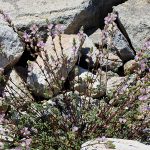
The Tubbs Fire inflicted catastrophic damage in the North Bay, including the Fountaingrove neighborhood of Santa Rosa, shown here on October 14, 2017. Photo courtesy Santa Rosa Fires / Flickr.com.
We’ve seen fire aplenty this year. The California wildfire season got off to an early, rip-roaring start and continues apace, stretching budgets and firefighters. The Mendocino Complex Fire crossed four county lines and is the largest California wildfire in history. It is also the nation’s largest wildfire this year so far, with 459,123 acres burned at 98 percent containment in early September. The most destructive wildfire in California history was the Tubbs Fire last year with 5,636 structures burned, 36,807 acres burned, and 22 deaths.
Soon we’re going to see rain, which we need, but which is also an ironic cause for concern for those who protect California’s water quality for people and the environment. Their main worry is the extra sediment carried in runoff through fire-damaged watersheds that drain into water-holding basins.
US Forest Service research hydrologist Joe Wagenbrenner explained how the system works in a balanced, unburned watershed. When it rains, as much as ninety percent of rainfall is absorbed by the soil. The rest evaporates or is used by plants. The water in the soil percolates down to recharge groundwater and move through the substrate into streams. “It takes a long time for a drop of water to move through the soil and reach a stream,” said Wagenbrenner. “As a benefit, the soil acts as a filter and the water comes out clean.” In a balanced system, sediment in water is good. It provides habitat for fish and carries with it soil nutrients such as organic carbon, phosphorus, potassium, and nitrogen. These nutrients provide food for fish and micro-invertebrates while replenishing floodplains and riverbanks.
In an unbalanced system such as a high-intensity burn area, there is too much sediment and a bloom of nutrients that are not good for water quality, said Wagenbrenner. In a burned area there is likely no vegetation to absorb some of the rainfall, and in some cases, waxy vegetation burns, melts, and forms a coat on the soil that repels water. A fire can also burn the organic matter in soil itself. Organic matter helps to hold soil together, and when it burns, it becomes more friable and won’t clump, making it more susceptible to erosion. With less water being absorbed by the soil, there is more runoff and more sediment on the move. As a result, the water is less clean because it hasn’t gone through the natural filtration of soil.
How water managers respond after a fire depends on the severity of the burn, said Sheri Miller, a senior sanitary engineer for the State Water Resources Control Board, which is responsible for protecting California’s water quality. “Each fire presents its unique set of circumstances,” she said, which leads her to look at how hot a fire burns, its damage to the watershed, and if water system facilities were harmed, either above or below ground. Maps of burn areas are generated and studied for the degree of burns. A high-severity burn creates greater impacts.
“There are things we can do to mitigate for fire impacts once the fire has happened,” said the Forest Service’s Wagenbrenner. To reduce erosion, they might apply seed or mulch before it rains. To slow down or trap moving water that carries sediment and ash, they can use straw wattles (straw-filled tubes bound by natural fiber) and log erosion barriers, or build check dams.
After the 2017 Tubbs Fire burned one side of Kimball Reservoir, a source of Calistoga’s drinking water supply, the city laid 7,000 linear feet of straw wattles around the reservoir. It helped. Water managers did additional water monitoring and didn’t see elevated levels of nutrients, said Miller.
Once runoff and sediment reach a municipal water supply, additional treatment may be necessary because sediment can change the pH of water. “Almost every contaminant can be removed, but the removal can be expensive,” said Wagenbrenner. Sediment does more than affect water quality and treatment approaches; it hastens the lifespan of a reservoir, which loses capacity as it ages and collects sediment.
“Fires have been here long before humans,” said Wagenbrenner, pointing out how the natural cycle of wildfires has historically served to benefit ecosystems. Medium- and low-intensity fires can benefit a watershed ecosystem by removing small trees, allowing mature trees to receive more nutrients and water, making them stronger to resist fire and disease. Also, removing fuel from a forest renders a fire less hot.
While it may seem that there are more reported fires each year, the number is relatively constant over time according to data from the California Department of Forestry and Fire Protection (CAL FIRE). What has increased exponentially over the last decade is the amount of acreage that burns. Three things control the size and sizzle of a fire, says Wagenbrenner. The biggest factor is local weather, which is growing more extreme due to climate change. “If it’s hot and dry, fuel will burn hotter and faster,” he said, “and if it’s windy all bets are off.” In wind, fires can jump barriers such as roads and streams, and spread the fire by “spotting” other fires downwind. Variables in firefighting efficacy due to the size of the fire, resources, and wind condition can also affect the size and intensity of a fire.
Fuel conditions on the ground are another important factor. Most fires spread on the ground, not from tree canopy to canopy, so what is on the ground matters. That’s where forest management comes in. “Maintaining a healthy forest is one way to help prevent large fires,” said CAL FIRE’s Dennis Hall. “And preventing large wildfires is one way to protect water supplies in the future.” Healthy forest management reduces fuel for fires by harvesting trees, thinning and removing other vegetation, and by conducting prescribed burns.
Urban fires and wildland-urban interface fires add another level of concern for water quality. After the Tubbs Fire, the North Coast Regional Water Quality Control Board was concerned that hazardous waste from over 5,000 burned structures would enter waterways. Working with CAL FIRE and other agencies, the Regional Water Board identified high risk areas in need of protection within the Russian River watershed. The data was used to mitigate post-fire runoff and erosion, including the use of straw wattles to keep soil and structure material onsite and not in creeks. After a post-fire monitoring, they found that their efforts were successful.
In an urban fire, the burning of water delivery pipes can also be a problem. KQED reported that pipes made of high-density polyethylene that burned in Santa Rosa’s Fountaingrove neighborhood delivered toxins to the water mains.
A disaster like a fire can bring communities together, and those in Lake County are a good example. These communities have a history of fire and are accustomed to dealing with sediment from Clear Lake, the oldest lake in America. (Old lakes are full of sediment.) “In Lake County, there are emergency protocol systems in place and the communities have learned to network with each other,” said Miller, who added, “We were lucky with the Mendocino Complex Fire. There are 50 water systems we have control of on the lake and only one sustained damage.”
The State Water Board encourages small and large water entities to plan by protecting water treatment plants and storage tanks with defensible space. Smaller water delivery services, such as those serving homeowner associations, should know in advance if insurance covers fire events, and consider lining up adequate administrative support for needed paperwork.
Fires are here to stay. They can’t always be controlled, but there is much we can do through smart planning to lessen their intensity and mitigate their impact so that rain is always welcome.
Aleta George (usually) covers open space for the Monitor.

